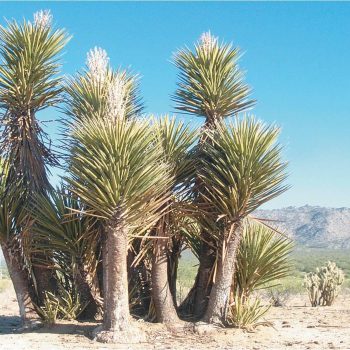Aloe Vera is a succulent, with long narrow leaves similar to Century Plant and agave. The leaves have a dark green outer skin, and a clear gel inside the leaf, like a cactus. It is best known for the pain-killing properties of the juice when it is applied to a burn; we have a plant growing at the factory, and welders cut off a slice and rub it on burns. Commercially it is used in the manufacture of cosmetics, beverages, and nutraceuticals.
Vincent Corporation participated in aloe vera tests with a screw press at Aloecorp in Gonzalez, Tamaulipas, in northern Mexico. Aloecorp makes several products. The valuable product is aloe gel, which they get from the core of the leaf. It is like slightly opaque, almost clear, Jell-O.
The harvested leaves are washed in a floatation trough, the tails are cut off, and the pieces go to operators, each with a filleting machine. The filleting machine is fed, by hand, the pieces of leaf. These pieces are about 16″ long, 4″ wide, and 1-1/2″ thick at the center, with a row of coarse, dull spines down each edge. The Aloecorp homemade filleting machines first slice the leaf in half, widthwise along the center. Then the machine slices a long, clear filet of aloe gel from each half of the leaf. The two fillets fall into a trough, where they flow by gravity to the suction of a small centrifugal pump. These pure-gel fillets first a go though a Brown finisher. Then the gel is pumped to a plate and frame filtration machine. From there the gel goes to a pasteurizer. From there it can go to a GEA (Niro) evaporator for concentration. The finished product is kept chilled.
The concentrate is sold in 5-gallon pails, 55-gallon drums, and one ton bulk containers.
Some concentrate is sent to a belt dryer, about 30′ long. The belt, a meter wide, is made of Mylar. At the discharge end, a doctor blade scrapes the dried aloe from the Mylar. Thin, crumbly flakes are produced in this manner.
The filleting machines capture 40% to 50% of the leaf, by weight, as pure gel. They process 120 tons per day of leaf, in 16 hours. That gives them 60 tons per day of skin and tails.
All our work was with skins and tails. A juice yield of 38% to 43% by weight was achieved. The Vincent KP-6 press did 320 kg/hr. The trouble is that, with a chromatograph, it is possible to detect undesirable spikes if there is skin in the gel. It seems inevitable that they will get the occasional spike from our press liquor.
An alternate product produced by the factory in called “whole leaf”. They convey the whole leaves (with skin), washed, into an angle disintegrator. This product is inferior in value to aloe gel, so they avoid producing it. Nevertheless, our screw press proved well suited for this application.
When pressing skins and tails, the press liquor from our press was of better quality than whole leaf gel, but we would have occasional spikes that rarely appear in the aloe gel. It was not clear how much added value this represents.
The press ran well at 120 Hz (40 rpm), and it also ran well at 30 Hz. The rotating cone helped, especially with the pin on the face of the cone which turns inside the cake discharge spout. The aloe is very acid, so all our carbon steel parts were showing rust. Operation with the reversing VFD showed no advantage.
The press made press liquor that was noticeably more clear when we switched from a slotted 0.015″ wedgewire screen to a round 0.030″ perforation screen. However, following further testing, the wedgewire screen was selected as the better choice.
Three key tests were un. Tests #1 and #2 were with 20 psi cone pressure and 120 Hz. #1 was with a 0.015″ wedgewire screen, #2 and #3 were with the .030″ perf screen. #3 was with 10 psi cone pressure and 30 Hz. All these tests were run with the VFD in forward only (no reversing).
- Test #1 achieved 324 kg/hr throughput and 40% juice yield.
- Test #2 achieved 321 kg/hr throughput and 43% juice yield.
- Test #3 achieved 103 kg/hr throughput and 38 % juice yield.
In an effort to get press liquor that was less contaminated with outer skin, we removed the resistor bar and replaced it with a dummy bar. With no resistor teeth, the press flat out stopped working. High speed, low speed, open cone, reversing VFD: nothing would get aloe to go through the press.
Aloecorp has about 1,200 hectares growing Aloe Vera around the factory. They grow 80% of their needs themselves, and they buy the rest from nearby growers. They have set up a factory to do the same thing in China.

